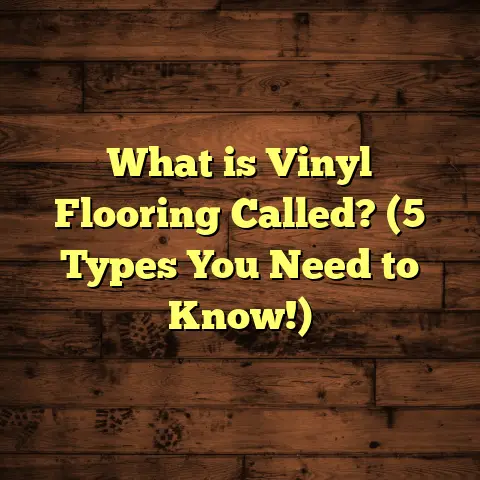What is Glazed Ceramic Floor Tile? (5 Benefits You Didn’t Know)
What is Glazed Ceramic Floor Tile?
When I first started my flooring career, I quickly noticed how many options exist out there, and how confusing it can be for homeowners to pick the right one. Among all those choices, glazed ceramic floor tile stood out for me early on. Its unique combination of beauty and durability made it an easy recommendation for kitchens, bathrooms, and even busy commercial spaces.
So what exactly is glazed ceramic floor tile? Simply put, it’s a ceramic tile coated with a glass-like substance called glaze. During manufacturing, this glaze is fused to the tile body by firing it in a kiln at a very high temperature. This process creates a smooth, often shiny surface that seals the tile beneath.
Unlike unglazed ceramic tiles which have a rougher, more porous surface, glazed tiles have that protective outer layer that enhances their resistance to moisture, stains, and wear. I’ve used glazed ceramic tiles in various projects where both function and aesthetics matter. But the benefits go far beyond just surface shine.
Why I Choose Glazed Ceramic Floor Tiles: A Personal Perspective
Let me share a story from my early days as a flooring contractor. I was working on a kitchen remodel for a young family with two toddlers. They wanted a floor that looked good but could also withstand spills, muddy footprints, and the occasional dropped cup of juice.
We chose glazed ceramic tiles with a subtle texture and soft matte finish. Six months in, the family reported how easy the floor was to clean and maintain. No staining from juice or grime buildup in grout lines. That experience convinced me that glazed ceramic tiles are not just pretty—they’re practical.
Over the years, I’ve installed these tiles in homes, restaurants, offices—you name it. The versatility and resilience always impress me. If you want flooring that can take real life and still look great, glazed ceramic tiles should be on your shortlist.
1. Stain and Water Resistance That Holds Up Over Time
One of the biggest advantages I’ve seen firsthand is how well glazed ceramic tiles resist water and stains. The glaze forms a non-porous barrier that liquids can’t penetrate easily. This makes cleaning spills quick and straightforward—just wipe it up without worrying about permanent damage.
How Does This Work?
Ceramic tiles themselves are made from natural clays fired at high temperatures, which makes them hard but somewhat porous. The glaze layer fills in microscopic pores and creates a seal. This decreases water absorption drastically—usually below 0.5% for glazed tiles.
In comparison:
- Unglazed ceramic tiles absorb between 3% to 7% water.
- Porcelain tiles often have absorption rates under 0.5%, similar to glazed ceramics but typically denser.
This low absorption rate makes glazed ceramic ideal for wet areas like kitchens, bathrooms, laundry rooms, and even basements prone to humidity.
Real-World Experience
For example, I installed glazed ceramic tiles in a restaurant kitchen where spills are constant—from oils to sauces. The staff told me cleanup time dropped significantly because the surface didn’t stain or trap grease.
Pro Tip: Sealing Grout Lines
While the tile surface is resistant, grout lines can soak up moisture if left unsealed. I always recommend applying a high-quality grout sealer every 1-2 years to maintain overall water resistance in tiled areas.
2. Scratch and Wear Resistance Keeps Floors Looking New
Another benefit I value in glazed ceramic tiles is their scratch resistance. In my line of work, floors get tested daily—furniture dragged, kids running wild, pets scratching. Glazed ceramics handle all this better than many flooring materials.
What Makes Them So Durable?
The glaze is not just for looks; it’s hard and dense. On the Mohs scale of mineral hardness (1 being softest like talc, 10 being diamond), glazed ceramic tiles generally rate between 6 and 7. For comparison:
- Hardwood floors rate around 3-5 depending on species.
- Vinyl flooring is much softer.
- Porcelain tiles often rate slightly higher than regular ceramics due to denser composition.
This means everyday objects—shoes with grit on soles, pet claws, even falling keys—don’t easily scratch or dull the surface.
Data on Longevity
Studies from tile manufacturers show glazed ceramic floors can last 20+ years with minimal visible wear when properly installed and maintained.
My Experience With Commercial Spaces
I recently worked on a boutique retail store renovation where they selected patterned glazed ceramic tiles for their floors. After two years of heavy foot traffic—even with trolleys and display racks—the floors looked nearly new. The owner was thrilled with how they resisted scratches compared to the wood floors they had before.
3. Design Variety That Lets You Get Creative
If you’re someone who enjoys putting personality into your space, glazed ceramic tiles are a fantastic option because they come in so many colors, patterns, textures, and sizes. The glaze acts like a canvas where manufacturers can print or apply designs that remain vibrant over time.
Why Does Design Variety Matter?
I’ve seen clients overwhelmed by choices but also excited by how easily they can customize their floors without compromising durability.
Here are some of the design options you can find:
- Natural stone looks: Marble, granite, travertine imitations with realistic veining.
- Wood-look tiles: Perfect for wet areas where hardwood wouldn’t hold up.
- Bold geometric patterns: Great for accent walls or statement floors.
- Textured finishes: Matte or lightly textured glazes add slip resistance without losing style.
- Large format tiles: Big squares or rectangles create a seamless modern look.
Unique Insight: How Glaze Enhances Colors
The glaze not only protects but also intensifies colors by reflecting light differently than unglazed surfaces. That’s why colors stay vibrant longer and don’t fade easily under sunlight or cleaning agents.
Case Study: Patterned Floor Revival
I helped renovate an old home where the owners wanted to maintain some vintage charm but modernize durability. We chose glazed ceramic tiles with classic Moroccan patterns printed under the glaze layer. This gave them authentic style combined with easy care—a perfect blend of old and new.
4. Easy Maintenance That Saves Time and Money
One thing I always emphasize with clients is that flooring should reduce hassle day-to-day—not add to it. Glazed ceramic tiles excel here because their smooth surface doesn’t trap dirt easily.
What Does Maintenance Look Like?
Routine cleaning is simple—sweeping or vacuuming followed by mopping with warm water and mild detergent usually does the trick. There’s no need for waxing or polishing like hardwood or stone floors require.
Why This Matters Financially
Less maintenance means fewer cleaning products needed and less labor time spent—saving money over years of use. Plus, if damage occurs on other durable floors, repairs can be costly; glazed ceramics usually avoid this due to their resilience.
Anecdote From My Work
I once installed these tiles in an elderly care facility where staff appreciated how easy it was to keep floors sanitary without harsh chemicals or excessive scrubbing. It reduced their cleaning time significantly each day while maintaining hygienic conditions.
Watch Out For…
While glazed surfaces are tough, avoid abrasive cleaners or steel wool pads that could dull the glaze over time.
5. Cost-Effective Flooring Solution for Long-Term Use
Money talks loudly when planning any renovation or build project. Glazed ceramic floor tiles strike a good balance between upfront cost and long-term value.
Price Breakdown
In my projects across different regions:
- Material costs range roughly from $2 to $7 per square foot depending on quality and design.
- Installation labor varies widely but typically adds $3 to $8 per square foot.
- Adding grout sealing and underlayment may add small costs but improve longevity significantly.
How I Manage Budgeting
I use FloorTally regularly—a tool that helps me input room size, material choice, labor rates in my area to generate accurate cost estimates quickly. It includes waste factors so I don’t underestimate materials needed.
This prevents surprises mid-project and helps clients make confident decisions aligned with their budgets without sacrificing quality.
Value Over Time
Due to their durability and low upkeep needs, glazed ceramic tiles often outlast cheaper flooring options that require frequent replacement or repairs—making them economical for long-term use.
Additional Insights About Glazed Ceramic Floor Tiles
Installation Tips From My Experience
Installing glazed ceramic tile properly is crucial for performance:
- Subfloor Prep: Make sure the subfloor is level and clean to avoid cracks later.
- Use Quality Adhesive: Thinset mortar designed for ceramic tiles ensures strong bonding.
- Grout Selection: Choose grout color carefully—lighter grout shows dirt more but highlights tile design; darker grout hides stains better.
- Seal Grout: As mentioned earlier, sealing grout protects against moisture penetration.
- Expansion Joints: For large areas, include expansion joints to prevent cracking from temperature changes or shifting floors.
Common Mistakes to Avoid
- Using unglazed tiles in high-moisture areas without sealing.
- Skimping on grout sealing leading to mold buildup.
- Choosing very glossy glazed tiles in slippery zones without anti-slip treatment.
- Not accounting for tile waste during ordering—usually order 10% extra.
What About Environmental Impact?
Ceramic tiles use natural materials like clay and sand but require energy-intensive firing. However, their long lifespan reduces need for replacement waste compared to less durable flooring. Some manufacturers now produce eco-friendly glazes with lower emissions during firing.
Comparing Glazed Ceramic Tiles With Other Floorings I’ve Worked With
When advising clients who ask about alternatives:
| Flooring Type | Durability | Maintenance | Price Range (Material) | Design Options | My Take |
|---|---|---|---|---|---|
| Glazed Ceramic Tiles | High (scratch & stain resistant) | Easy (simple cleaning) | $2–$7/sq ft | Wide variety | Best balance of durability & style |
| Porcelain Tiles | Very High | Easy | $4–$10/sq ft | Wide variety | More durable but pricier |
| Hardwood | Moderate | Moderate (polish/seal) | $5–$15/sq ft | Limited (wood grains) | Beautiful but needs more upkeep |
| Laminate | Moderate | Easy | $1–$5/sq ft | Moderate | Affordable but less durable than tile |
| Vinyl | Moderate | Easy | $1–$6/sq ft | Many designs | Cheap & flexible but less long-lasting |
Final Thoughts From My Flooring Journey
I’ve installed thousands of square feet of glazed ceramic floor tiles over the years across many types of projects—from cozy homes to bustling business spaces—and they rarely disappoint.
If you want flooring that combines beauty with practicality; resists stains, scratches, water; offers endless design choices; stays easy to clean; all while fitting reasonable budgets—I’d say glazed ceramic tiles deserve serious consideration.
Have you ever thought about using them? Or maybe you already have? I’d love to hear your experiences or questions about these versatile floors!
If you want help figuring out costs or choosing materials for your next project, tools like FloorTally have been game changers for me—they save time and help avoid budget shocks by providing clear cost breakdowns upfront.
Feel free to ask if you want me to walk you through how I use such tools alongside my flooring know-how!
This completes a detailed look at glazed ceramic floor tile benefits plus actionable advice from my hands-on experience. If you want me to expand any section further or focus on specific scenarios like bathroom installations or commercial uses, just let me know!





